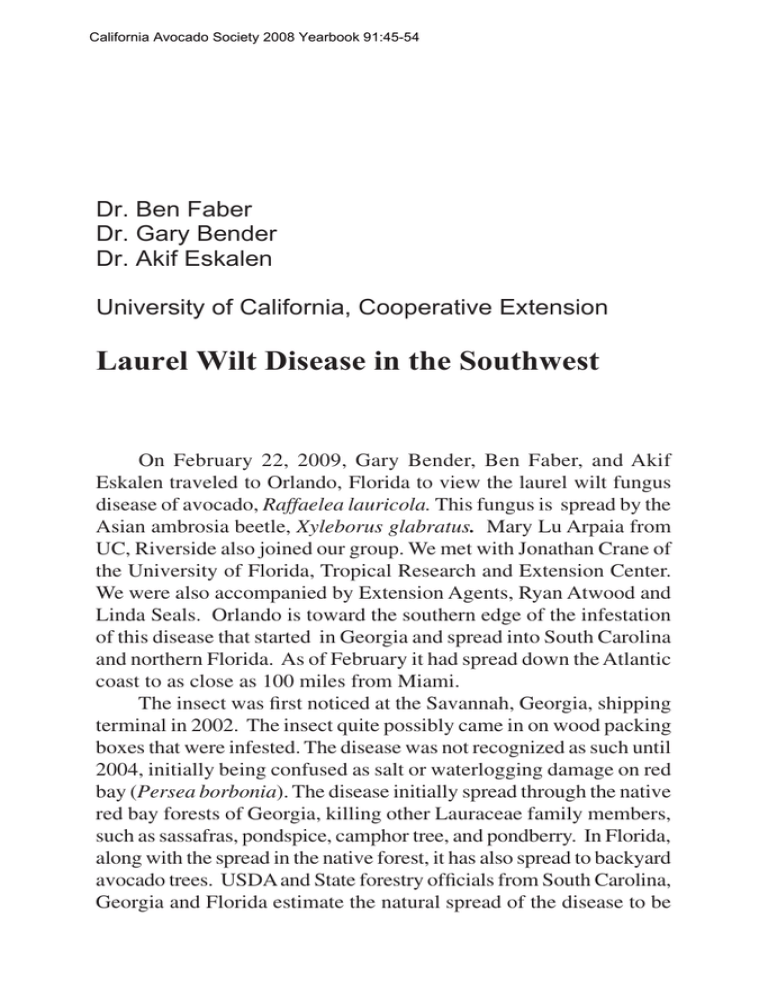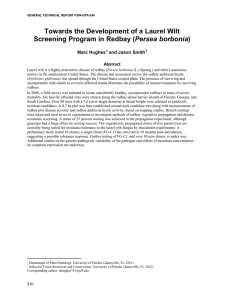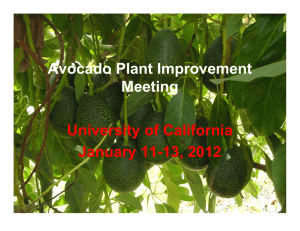Laurel Wilt Disease in the Southwest Dr. Ben Faber Dr. Gary Bender
advertisement

California Avocado Society 2008 Yearbook 91:45-54 Dr. Ben Faber Dr. Gary Bender Dr. Akif Eskalen University of California, Cooperative Extension Laurel Wilt Disease in the Southwest On February 22, 2009, Gary Bender, Ben Faber, and Akif Eskalen traveled to Orlando, Florida to view the laurel wilt fungus disease of avocado, Raffaelea lauricola. This fungus is spread by the Asian ambrosia beetle, Xyleborus glabratus. Mary Lu Arpaia from UC, Riverside also joined our group. We met with Jonathan Crane of the University of Florida, Tropical Research and Extension Center. We were also accompanied by Extension Agents, Ryan Atwood and Linda Seals. Orlando is toward the southern edge of the infestation of this disease that started in Georgia and spread into South Carolina and northern Florida. As of February it had spread down the Atlantic coast to as close as 100 miles from Miami. The insect was first noticed at the Savannah, Georgia, shipping terminal in 2002. The insect quite possibly came in on wood packing boxes that were infested. The disease was not recognized as such until 2004, initially being confused as salt or waterlogging damage on red bay (Persea borbonia). The disease initially spread through the native red bay forests of Georgia, killing other Lauraceae family members, such as sassafras, pondspice, camphor tree, and pondberry. In Florida, along with the spread in the native forest, it has also spread to backyard avocado trees. USDA and State forestry officials from South Carolina, Georgia and Florida estimate the natural spread of the disease to be California Avocado Society 2008 Yearbook 91:45-54 17-20 miles per year, but human intervention through movement of infested firewood has accelerated the disease distribution (see figure 5). The insect carrying the fungal disease can fly and with its small size can easily be wind-borne. It spends much of its lifecycle in the wood. There are notices in the three states about not moving firewood, but there is little enforcement. Laurel family members from nurseries are not restricted in their movement, other than by standard nursery sanitation criteria. Aside from avocado here in California, the insect and disease could go to California native bay laurel (Umbellularia californica) found in coastal California through Oregon and in the landscape tree, camphor (Cinnamomum camphora). We traveled in the Orlando area and saw backyard avocado trees that had rapidly died from the disease (see figures 1-4). It appears that only one beetle is needed to cause the disease. It bores into the xylem, inoculates the wood as future food source for their larvae, spreading the fungus. The fungus clogs the xylem and trees can collapse within a short time. It is thought that through root grafts, the fungus can spread to neighboring trees. In a number of the dead trees we saw numerous entry and exit holes, indicating that more than one beetle had attacked the trees. This part of the state is too cold for commercial avocado orchards, but there are backyard trees. Tree collapse looks very similar to freeze damage, with brown leaves still hanging. It was not hard to identify collapsed backyard trees. From Orlando we went to Savannah for the Laurel Wilt Conference. Just prior to the meeting the Laurel Wilt Workgroup met. This group has 18 members drawn from USDA, state foresters, and University of Florida faculty headed up by Randy Ploetz, a plant pathologist at the University of Florida. We are in the process of seeking a USDA Specialty Crops grant to further study laurel wilt. Ploetz and several other faculty, such as Jorge Pena, Jason Smith and Jonathan Crane have been looking into the pest/disease complex with money from the Florida Avocado Administrative Committee. Several of their trials have shown some degree of variability in disease susceptibility in avocado. They have identified manuka oil and phoebe oil as successful attractants for the ambrosia beetle, but a wounded tree acts as an attractant as well. At this point, they have not identified an effective insecticide or fungicide as a control. Work is continuing California Avocado Society 2008 Yearbook 91:45-54 in this area and we have been in discussions with members of the workgroup on better control tactics. As part of the conference we went on a tour of affected forests and witnessed the loss of red bay and sassafras. The federal and state foresters who have been monitoring the spread of the disease were quite open in discussing the shear difficulty in containing the spread of the disease. Red bay is native from South Carolina south to Florida and east to Texas, and the disease could easily spread throughout this area and possibly into Mexico. During the conference it was reported that the beetle could go to other non-laurel species such as Calychanthus floridus and Cercis canadensis, which would substantially increase the range in which this insect could move (Steve Fraedrich, US Forest Service). In the southeast, the female beetles fly predominantly in the fall, but they have been trapped year round. They are most attracted to red or blue sticky cards and much less so to yellow. The beetles have been trapped at heights as high as 45 feet, so they can easily get into trees without their entrance holes being noticed. Wounded trees are also attractive to the beetles. Manuka oil seems to be the most attractive odor (all five of these last comments were made by James Hanula, U.S. Forest Service). Jason Smith (University of Florida) has found multiple genotypes of the Raffaelea fungus with different virulence to avocados. This also probably indicates that there have been multiple introductions of the fungus and beetle. Jorge Pena and others indicated that the disease has not been reported to kill avocados in Asia, and that quite possibly there are areas where the less virulent strains are found. At this point it is mainly Florida that is doing avocado research on the disease, and how to control both it and the beetle. The threat to avocados is world-wide and it would seem that Florida is where we should put resources to stopping this problem that could affect all avocado growers. California Avocado Society 2008 Yearbook 91:45-54 Figure 1 Vascular staining in avocado with beetle entry holes. Figure 2 Avocado collapsed, one year old. New shoots will collapse. California Avocado Society 2008 Yearbook 91:45-54 Firgure 3 Multi-trunked avocado in process of collapse. Figure 4 Red bay (P. borbonia) in collapse. California Avocado Society 2008 Yearbook 91:45-54 Figure 5 California Avocado Society 2008 Yearbook 91:45-54 Further Reading Atkinson, T.H. and S.B. Peck. 1994. Annotated checklist of the bark and ambrosia beetles (Coleoptera: Platypodidae and Scolytidae) of tropical southern Florida. Fla. Entomologist 7:313-329. Bryant, R.M. 2007. Laurel wilt disease or an ecological disaster. Division of Plant Industry, Florida Department of Agriculture and Consumer Services, January 2007. http://www.doacs. state.fl.us/pi/enpp/pathology/laurel_wilt_disease.html [Accessed 02-4-08]. Fraedrich, S.W., T.C. Harrington, R.J. Rabaglia, M.D. Ulyshen, A.E. Mayfield III, J.L. Hanula, J.M. Eikwort, and D.R. Miller. 2008. A fungal symbiont of the redbay ambrosia beetle causes a lethal wilt in redbay and other Lauraceae in the southeastern United States. Plant Disease 92:215-224. Gilman, E.F. and D.G. Watson. 2006. Persea borbonia: Redbay, EDIS Publication ENH-595. Envir. Hort. Dept., FL Coop. Extn. Service, IFAS, University of Florida, Gainesville, FL p. 1-3. http://edis.ifas.ufl.edu/ST436 [Accessed 02-4-08]. Hanula, J.L., A.E. Mayfield, S.W. Fraedrich, and R.J. Rabaglia. 2008. Biology and host associations of redbay ambrosia beetle (Coleoptera: Curculionidae: Scholytinae), exotic vector of laurel wilt killing redbay trees in the southeastern United States. Forest Entomology 101:1276-1286. Harrington, T.C., S.W. Fraedrich, and D.N. Aghayeva. 2008. Raffaelea lauricola, a new ambrosia beetle symbiont and pathogen on the Lauraceae. Mycotaxon 104:399-404. Mayfield III, A.E. 2007. Laurel wilt: a serious threat to redbay and other related native species. The Palmetto 24:8-11. Mayfield III, A.E. 2008. Laurel wilt. Forest and Shade Tree Pests. Fla. Dept. Agri. and Consumer Services, Div. of Forestry. Leaflet 13. p.1-2. Mayfield III, A.E. and M.C. Thomas. 2006. The redbay ambrosia beetle, Xyleborus glabratus Eichhoff (Scolytinae: Curculionidae). FDACS Div. of Plant Industry, Pest Alert p.1-2. Mayfield III, A.E., E.L. Barnard, J.A. Smith, S.C. Bernick, J.M. Eickwort, and T.J. Dreaden. 2008a. Effect of propiconazole California Avocado Society 2008 Yearbook 91:45-54 on laurel wilt disease development in redbay trees and on the pathogen in vitro. Arboriculture and Urban Forestry 34:317324. Mayfield III, A.E., J.E. Peña, J.H. Crane, J.A. Smith, C.L. Branch, E.D. Ottoson, and M. Hughes. 2008b. Ability of the redbay ambrosia beetle (Coleoptera: Curculionidae: Scolytinae) to bore into young avocado (Lauraceae) plants and transmit the laurel wilt pathogen (Raffaelea sp.). Florida Entomologist – Scientific Notes 91:485-487. Mayfield III, A.E., J.A. Smith, M. Hughes, and T.J. Dreaden. 2008c. First report of laurel wilt disease caused by a Raffaelea sp. on avocado in Florida. Ploetz, R.C. and J.E. Peña. 2007. Laurel wilt: a lethal disease on avocado and other Lauraceous hosts. University of Florida, IFAS, TREC Web site http://trec.ifas.ufl.edu p. 1-6. [Accessed 02-4-08]. Pollack, S. and A. Perez. 2007. Avocado. Fruit and Tree Nuts Situation and Outlook Yearbook. Market and Trade Economics Division, Economic Research Service, U.S. Department of Agriculture, October 2007, FTS-2007. Rabaglia, R.J., S.A. Dole, and A.I. Cognato. 2006. Review of American Xyleborina (Coleoptera: Curculionidae: Scolytinae) occurring north of Mexico, with an illustrated key. Annals of the Entomological Soc. of Amer. 99. Reid, L., B. Mayfield, and J. Johnson. 2008. Distribution of counties with laurel wilt disease symptoms by year of initial detection. http://www.fs.fed.us/r8/foresthealth/laurelwilt/ dist_map.shtml [Accessed 10-26-08]. Thomas, M.C. 2007. Two Asian ambrosia beetles recently established in Florida (Curculionidae: Scolytinae). Dept. Plant Industry, Florida Department of Agriculture and Consumer Services. http://www.doacs.state.fl.us/pi/enpp/ento/twonewxyleborines.html [Accessed 02-4-08]. US Forest Service. 2008. http://www.fs.fed.us/database/feis/plants/ tree/perbor/all.html [Accessed 10-25-08]. California Avocado Society 2008 Yearbook 91:45-54 Acknowledgements Jorge Pena, Randy Ploetz and Jonathan Crane along with other members of the Laurel Wilt Workgroup were extremely helpful in bringing us up to speed on this disease.


